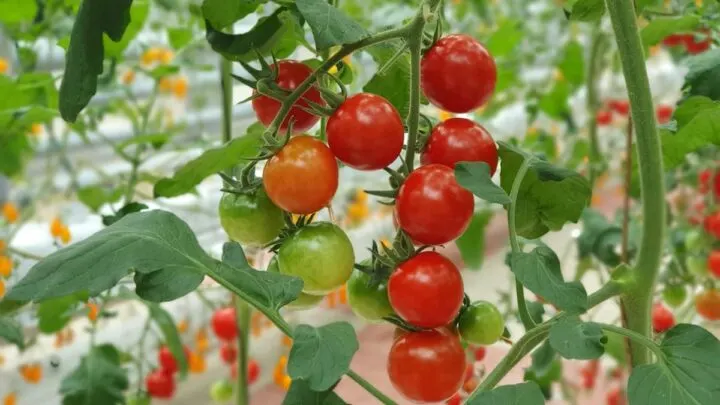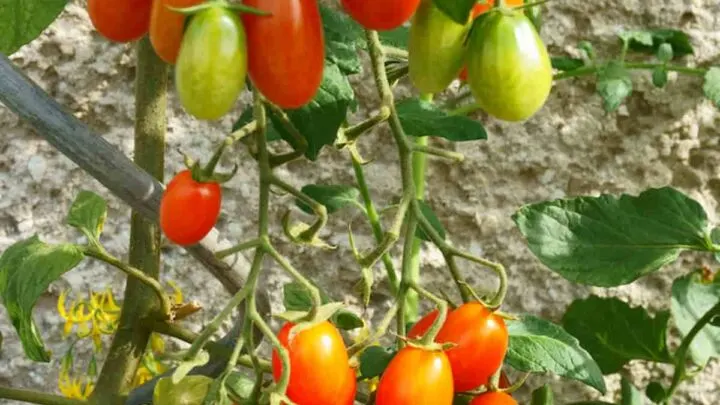Tomatoes are famous for bending over when stressed or just because they feel like it. There’s a reason most gardeners use tomato cages for these vine vegetables. Without them, your tomato is just as likely to damage its own stem as it bears fruit.
Plus, moving the tomato plant off the ground improves the chances that the tomato fruits will stay intact long enough to harvest.
Bendy tomato plants might be typical, but they’re far from ideal. Here’s what you need to know about tomato plant bending, what you can do about it, and how to tell when a tomato plant is beyond saving.
There are a few reasons tomato plants can fall over: transplant shock, lack of nutrients, and fungal infections.
Let’s dig in and see what you can do about tomato plants bending.

Why Are My Tomato Plants Falling Over?
There are a few reasons your tomato plants might fall over, depending on the circumstances your plants are in.
The most common reason for tomato plants to bend over is transplant shock. While normal, it’s important to monitor transplant-shocked plants to ensure they’re recovering and growing into the new soil.
This results from stress from the roots and stem being moved around, combined with new water and nutrient conditions in the new soil.
That said, matching the soil in your seedling pots to the soil in your garden can help reduce transplant shock. It’s also crucial to transplant when the tomatoes are ready – young tomatoes might be too small to safely transplant, and more mature tomatoes may be too big to transplant safely.
Another common reason for bending tomatoes is nutrient deficiencies. Tomato plants need lots of food to grow and thrive, so it’s essential to ameliorate your soil with compost and fertilizer.
Soil testing can help you figure out exactly which nutrients are missing, but often when tomato plants bend over, there isn’t enough Nitrogen and trace minerals in the soil. Or on the other hand, too much Nitrogen can make your tomato leaf out too much and fall over.
Add compost, a complete fertilizer, or coffee grounds to your tomato soil to fix nutrient deficiencies.
Lastly, bending stems can signify fungal infections and pest damage. Carefully inspect the stems for dark spots, white splotches, or any other discoloration or strange growths on the stem. Some diseases are treatable, while others call for removing the plant to save your other tomatoes and nightshade vegetables.

How Can You Fix A Bent Tomato Plant?
Sometimes, you can save your tomato plants depending on how bent your tomato has gotten. The first step is identifying the problem and ensuring your tomato has plenty of support from a tomato cage or trellis.
Next, check to see if one tomato is affected or if more than one plant is having problems. The more plants have issues, the more likely it is to be a nutrient deficiency or disease problem.
It’s also important to remember that bending can be a watering issue. If the soil around the tomato is too dry, it could be wilting.
Once you’ve identified the source of the bending, then you can treat it. If nutrients are needed, add some fertilizer today and again a couple of times over the next few weeks.
If watering is the issue, give your tomatoes a thorough watering and see if the plants perk up within a few hours. If they don’t, there is probably another issue causing the problem.
Diseases should be identified before treatment, and then use a disease-specific treatment to help your tomatoes perk up.
Can A Bent Tomato Stem Fix Itself?
Not usually, no. Tomato plants will straighten up some when the source of the problem is resolved, but they are a vining plant that needs some external support to stay upright. That also means that when your tomato plants bend over, you’ll need to help them straighten back up.

Can You Save A Plant With A Bent Stem?
It depends on how badly bent/crushed the stem is.
A stem with a gentle curve in it can usually be saved.
But if your tomato plant is creased or crushed near the bend or has bent more than 45 degrees, it might be more difficult or impossible to save.
That’s because the stem contains thin tubes, a lot like veins. Those tubes are responsible for moving water and nutrients throughout the plant, but they can’t be healed once damaged.
If the stem of your tomatoes bends so much that it crushes those tubes, the tomato stem can’t recover. Your plant will try to reroute around the crushed area using other tubes, but it may not be able to move enough water and nutrients.
Worse, the tubes on the other side of the crushed area may be stretched or torn and likely won’t be able to move much more water or nutrients than the crushed ones.
If possible, removing the bent stem and letting the plant focus on other areas might be better. But, if the main stem of your tomato is the bent one, or if the bend is close to your tomato’s roots, there may be nothing you can do.

Will Damaged Tomato Plants Recover?
Depending on the type of damage, your tomatoes will recover entirely from minor damage, mostly, but not wholly, from moderate damage and may need to be trimmed or assisted more after severe damage.
How To Prevent Tomato Bending
There aren’t any 100% certain ways to prevent tomato bending, but a few good options can help keep your tomatoes happier and healthier overall.
- Provide high-quality support in the form of tomato cages or similar
- Fertilize before planting and several times throughout the growing season to support adequate soil nutrition
- Water generously, allowing the soil to mostly dry between waterings. Water more often in hot temperatures and on days where the sun is particularly intense.
- Monitor tomatoes for signs of pests and disease and treat as soon as any symptoms are present
- Consider adding coffee grounds and other vegetable scraps to your garden, or use your own compost, to support good mineral and trace nutrient concentrations
- Provide extra shade on sunny days, especially if your tomatoes show signs of sun damage or start drooping.
Things To Consider
While tomato plants are naturally bendy plants and often fold over, they might be more likely to bend if they aren’t kept in good soil conditions.
In particular, tomato plants are both thirsty and hungry plants. They need a good amount of both water and fertilizer to thrive and can be damaged by even brief dry spells if you aren’t careful.
You also need to be careful not to burn the roots of your tomato plants with too much fertilizer. Always water your plants immediately after fertilizing, and try to wait at least two weeks between fertilizing.
Mulching the bottoms of your tomato plants can also be a good way to help keep water in loose soils and to prevent weeds and pests from stealing the water and nutrition your plants need.

Hi there, my name is Allie and welcome to my blog; GareningWithAllie!
Much of what you see written here is just our personal experiences with gardening. Along with the content I write here, there is also a unique collection of gardening topics covered by some of our close friends. I hope you find everything you read here to be helpful, informative, and something that can make your gardening journey the most lovely experience ever! With that said, Happy Gardening!
